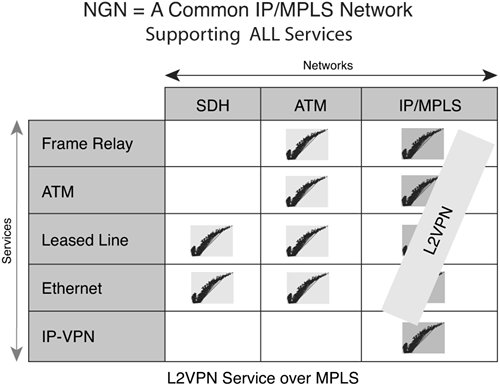MPLS and Next-Generation Networks: Foundations for NGN and Enterprise Virtualization
| Traditionally, service providers have deployed L2VPNs over Frame Relay and ATM, which has resulted in supporting multiple service networks as described in Chapter 1, "The Dynamics of Service Creation and Deployment." Similar to traditional private circuits, Frame Relay also has limitations, such as low bandwidth capacity, and deploying or modifying Frame Relay VPNs can be cumbersome because each individual circuit must be configured manually. A typical Frame Relay topology is hub and spoke, often burdening the hub with unnecessary transit traffic that impacts overall service efficiency, resiliency, and performance. For some carriers, Frame Relay still represents significant revenue for their business; however, the trend toward reducing operating expenses and offering customers better services (as described in Chapter 1) cannot be ignored by service providers. IP/MPLS offers a service provider the opportunity to converge such services onto a single network infrastructure and create additional value-added services, as is described later in this chapter. Figure 2-5 summarizes these service opportunities. Figure 2-5. NGN = A Common IP/MPLS Network Supporting All Services
The International Telecommunications Union-Telecom (ITU-T) standards body defines "NGN" (http://mailcenter.comcast.net/wm/toolbar/notheme.html#_ftn1) as "a packet-based network able to provide telecommunication services and able to make use of multiple broadband, QoS-enabled transport technologies and in which service-related functions are independent from underlying transport-related technologies. NGN enables unfettered access for users to networks and to competing service providers and/or services of their choice. It supports generalized mobility which will allow consistent and ubiquitous provision of services to users." The Cisco vision focuses on NGN convergence by the service provider of multiple services, where the converged platform could be IP/MPLS. A Layer 2 MPLS network using pseudowire technology enables the transport of various types of traffic across the IP/MPLS network as if it were a virtual wire. The IETF Pseudowire Edge (PWE) Working Group defines pseudowire mechanisms. Each of the ends of a pseudowire can possess the same Layer 2 encapsulation, such as ATM and Frame Relay. The connection between a CPE and a provider edge (PE) is referred to as an attachment circuit (AC). When both ACs of a pseudowire belong to the same encapsulation type at both ends of a pseudowire, this relationship is called like to like. In this case, because the data plane is still homogeneous (like to like) and both end points are of the same Layer 2 encapsulation even though there is no data plane interworking, the interworking function might involve some kind of network interworking at the control plane during the establishment of the pseudowire. Control plane interworking might be required when one attachment circuit is connected to a legacy ATM network (non-IP network) and the other end of the pseudowire attachment circuit might or might not be connected to the legacy network. The following are the various types of L2VPN:
Any-to-any L2VPN is formed when both end points of the attachment circuit are not homogeneous. In this case, both end points of an AC can belong to different Layer 2 services, such as ATM, Frame Relay, Ethernet, and so on. The service interworking conversion from one type to another can be performed at either of the end points and can be either signaled or provisioned at the corresponding end points. The following are common any-to-any configurations:
This deployment is called XoverMPLS for Layer 2 VPNs over MPLS. Some carriers might be reluctant to deploy such services because private circuits still represent a significant revenue for their business. However, Layer 2 VPNs over MPLS present an opportunity for carriers to generate new revenue opportunities for enterprise customers who might accept risk in service quality as a tradeoff for lower costs. For example, carriers can offer Frame Relay services over Layer 2 MPLS VPNs by encapsulating Frame Relay in MPLS frames. One motivation to migrate to a Layer 2 over MPLS business model can be depicted by the example of a global service provider offering the following types of services to enterprises and carriers: IP, Internet access, IP transit, IP-VPN and legacy voice, FR, ATM, and X25 where the majority of traffic is IP based. Further, one can observe that IP is becoming a larger part of the transport traffic mix. The current transport traffic mix is approximately:
Up to now, all this IP and legacy traffic had been consolidated over the service provider's Layer 2 ATM backbone. The service provider seeks opportunities and alternatives for cost reduction by migrating the backbone from ATM to IP/MPLS. On a site-by-site basis, a service provider's wide range of connectivity offeringssuch as ATM, Frame Relay, Ethernet, or DSLmust be considered and matched to the networking requirements for that site. If a Layer 2 connectivity option is being considered for some sites, the factors for making the decision include:
Chapter 4 describes the technology details for Layer 2 VPN constructs over MPLS. |
